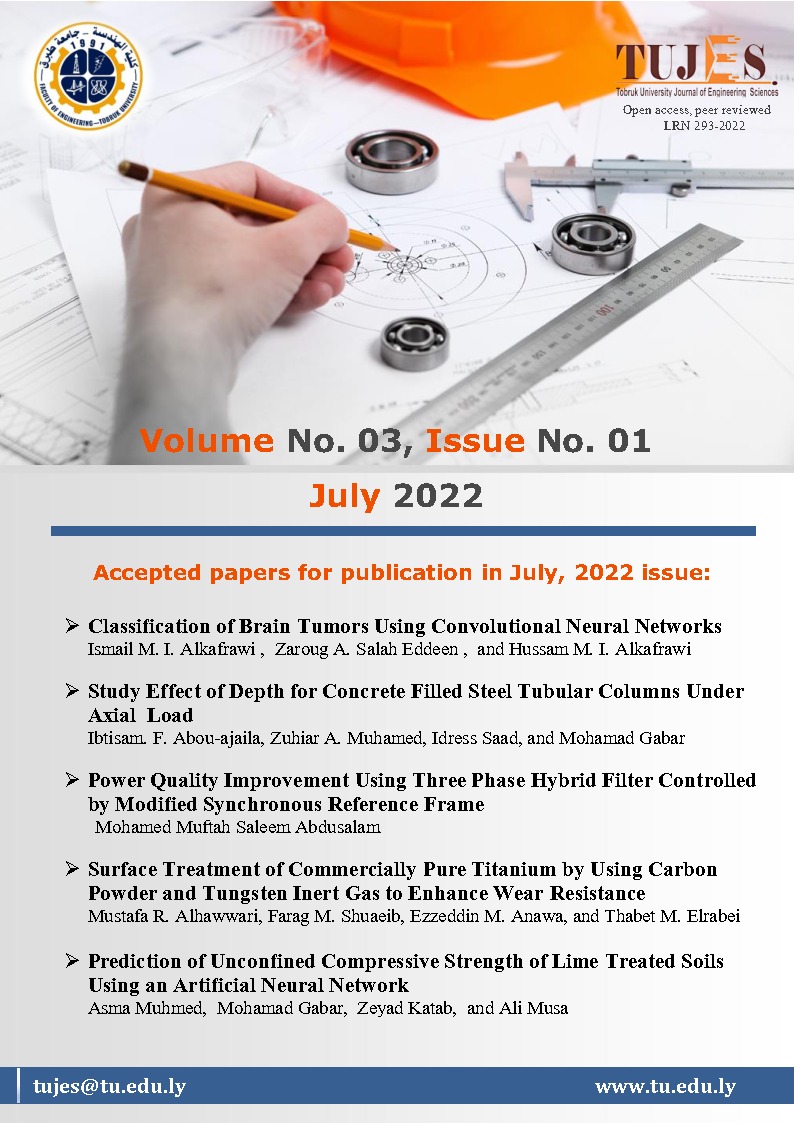Prediction of Unconfined Compressive Strength of Lime Treated Soils Using an Artificial Neural Network
DOI:
https://doi.org/10.64516/fpazvt12Keywords:
unconfined compressive strength, lime stabilisation, artificial neural networkAbstract
Robust model based on Artificial-Neural-Network was proposed to predict the Unconfined Compressive Strength (UCS) of lime treated soils. In total, an experimental database using 1120 test specimens was created. Critical examination of the collected experimental data suggested that there are eight key parameters that govern the attained strength gain. These input parameters are; liquid limit, plastic limit, dry unit weight, water content, fine content, lime content, curing temperature and curing time whereas the only output dependent parameter is the UCS. The parameters of the proposed model including weights, biases and transfer functions were successfully converted to an explicit mathematical model relating the UCS with the key input parameters. Based on the results of the statistical evaluation, it was shown that a three-layered Artificial-Neural-Network model with 19 hidden neurons was capable to predict the UCS of lime treated soils with a high degree of accuracy. A coupling effect of the input parameters and weights analysis were conducted for the developed Artificial-Neural-Network-model to assess the importance of the key parameters.
References
1. Ali, H. and M. Mohamed, ''Assessment of lime treatment of expansive clays with different mineralogy at low and high temperatures''. Construction and Building Materials, 2019. 228: p. 116955.
2. Anggraini, V., et al., ''Relationship between the compressive and tensile strengths of lime-treated clay containing coconut fibres''. Acta Geotechnica Slovenica, 2015. 12(1): p. 49-57.
3. Ismeik, M. and F. Shaqour, ''Effectiveness of lime in stabilising subgrade soils subjected to freeze–thaw cycles''. Road Materials and Pavement Design, 2020. 21(1): p. 42-60.
4. Jahandari, S., et al., ''Experimental study of the effects of curing time on geotechnical properties of stabilized clay with lime and geogrid''. International Journal of Geotechnical Engineering, 2019. 13(2): p. 172-183.
5. Shenal Jayawardane, V., et al., ''Expansive and Compressibility Behavior of Lime Stabilized Fiber-Reinforced Marine Clay''. Journal of Materials in Civil Engineering, 2020. 32(11): p. 04020328.
6. Ali, H. and M. Mohamed, ''The effects of compaction delay and environmental temperature on the mechanical and hydraulic properties of lime-stabilized extremely high plastic clays''. Applied Clay Science, 2017. 150: p. 333-341.
7. Gunaydin, O., A. Gokoglu, and M. Fener, ''Prediction of artificial soil’s unconfined compression strength test using statistical analyses and artificial neural networks''. Advances in Engineering Software, 2010. 41(9): p. 1115-1123.
8. Motamedi, S., et al., ''Application of adaptive neuro-fuzzy technique to predict the unconfined compressive strength of PFA-sand-cement mixture''. Powder technology, 2015. 278: p. 278-285.
9. Sharma, L., et al., ''Evaluating the modulus of elasticity of soil using soft computing system''. Engineering with Computers, 2017. 33(3): p. 497-507.
10. Tinoco, J., et al., ''Predictive and Prescriptive Analytics in Transportation Geotechnics: Three Case studies''. Transportation Engineering, 2021: p. 100074.
11. Dehghanbanadaki, A., et al., ''A study on UCS of stabilized peat with natural filler: a computational estimation approach''. KSCE Journal of Civil Engineering, 2019. 23(4): p. 1560-1572.
12. Hanandeh, S., A. Ardah, and M. Abu-Farsakh, ''Using artificial neural network and genetics algorithm to estimate the resilient modulus for stabilized subgrade and propose new empirical formula''. Transportation Geotechnics, 2020. 24: p. 100358.
13. Kumar, A. and S. Rupali, ''Prediction of UCS and STS of Kaolin clay stabilized with supplementary cementitious material using ANN and MLR''. Advances in Computational Design, 2020. 5(2): p. 195-207.
14. Sabat, A.K., ''Prediction of California bearing ratio of a soil stabilized with lime and quarry dust using artificial neural network''. Electronic Journal of Geotechnical Engineering, 2013. 18: p. 3261-3272.
15. Das, S.K., P. Samui, and A.K. Sabat, ''Application of artificial intelligence to maximum dry density and unconfined compressive strength of cement stabilized soil''. Geotechnical and Geological Engineering, 2011. 29(3): p. 329- 342.
16. Mozumder, R.A. and A.I. Laskar, ''Prediction of unconfined compressive strength of geopolymer stabilized clayey soil using artificial neural network''. Computers and Geotechnics, 2015. 69: p. 291-300.
17. Mohammadi, M., et al., ''Prediction of the shear strength parameters from easily-available soil properties by means of multivariate regression and artificial neural network methods''. Geomechanics and Geoengineering, 2022. 1 7(2): p. 442-454.
18. Salahudeen, A., et al., ''Prediction of unconfined compressive strength of treated expansive clay using back- propagation artificial neural networks''. Nigerian Journal of Engineering Vol, 2020. 27(1).
19. Sinha, S.K. and M.C. Wang, ''Artificial neural network prediction models for soil compaction and permeability''. Geotechnical and Geological Engineering, 2008. 26(1): p. 47-64.
20. Park, H. and Y. Kim, 'Prediction of strength of reinforced lightweight soil using an artificial neural network'. Engineering Computations, 2011.
21. Townsend, D.L. and T.W. Klym, ''Durability of lime-stabilized soils''. Highway Research Record, 1966. 139: p. 25-41.
22. Bell, F., ''Lime stabilization of clay minerals and soils''. Engineering geology, 1996. 42(4): p. 223-237.
23. Consoli, N.C., L. da Silva Lopes Jr, and K.S. Heineck, ''Key parameters for the strength control of lime stabilized soils''. Journal of materials in Civil Engineering, 2009. 21(5): p. 210-216.
24. Nasrizar, A., M. Muttharam, and K. Illamparuthi. ''Role of lime content on soil-lime reaction under thermal curing''. in Indian Geotechnical Conference–2010, GEOtrendz. 2010.
25. Nasrizar, A.A., M. Muttharam, and K. Ilamparuthi, ''Effect of placement water content on strength of temperature cured lime treated expansive soil'', in Ground Improvement and Geosynthetics. 2010. p. 174-180.
26. Ramesh, H.N.G. and P.V. Sivapullaiah, ''Role of moulding water content in lime stabilisation of soil''. Proceedings of the Institution of Civil Engineers-Ground Improvement, 2011. 164(1): p. 15-19.
27. Yıldız, M. and A. Soğancı, ''Effect of freezing and thawing on strength and permeability of lime-stabilized clays''. Scientia Iranica, 2012. 19(4): p. 1013-1017.
28. Schanz, T. and M.B. Elsawy, ''Swelling characteristics and shear strength of highly expansive clay–lime mixtures: A comparative study''. Arabian Journal of Geosciences, 2015. 8(10): p. 7919-7927.
29. Elkady, T.Y., ''The effect of curing conditions on the unconfined compression strength of lime-treated expansive soils''. Road Materials and Pavement Design, 2016. 17(1): p. 52-69.
30. Dayioglu, M., B. Cetin, and S. Nam, ''Stabilization of expansive Belle Fourche shale clay with different chemical additives''. Applied Clay Science, 2017. 146: p. 56-69.
31. Maubec, N., D. Deneele, and G. Ouvrard, ''Influence of the clay type on the strength evolution of lime treated material''. Applied Clay Science, 2017. 137: p. 107-114.
32. James, J. and P.K. Pandian, ''Bagasse ash as an auxiliary additive to lime stabilization of an expansive soil: strength and microstructural investigation''. Advances in Civil Engineering, 2018. 2018.
33. Bouras, F., et al. ''Effect of Hydrated Lime and Cement on the Engineering Behavior of Highly Expansive Clay''. in 9th Annual International Conference on Civil Engineering. 2019.
34. Ghorbani, A., et al., ''Effect of selected nanospheres on the mechanical strength of lime-stabilized high-plasticity clay soils''. Advances in Civil Engineering, 2019. 2019.
35. Islam, S., et al., ''Strength development in fine-grained paddy field soil by lime addition''. Journal of Building Engineering, 2019. 26: p. 100857.
36. Jha, A.K. and P. Sivapullaiah, ''Lime stabilization of soil: a physico-chemical and micro-mechanistic perspective''. Indian Geotechnical Journal, 2019: p. 1-9.
37. Kumar, S., Mahato, R. K., Kumar, N. , Ranjan, N. ,Mondal, D. and Chowdhury, S, ''Effect of Lime (Content & Duration) on Strength of Cohesive Soil''. International Research Journal of Engineering and Technology (IRJET), 2019. 6(5).
38. Tanzadeh, R., M. Vafaeian, and M.Y. Fard, ''Effects of micro-nano-lime (CaCO3) particles on the strength and resilience of road clay beds''. Construction and Building Materials, 2019. 217: p. 193-201.
39. James, J., ''Sugarcane press mud modification of expansive soil stabilized at optimum lime content: Strength, mineralogy and microstructural investigation''. Journal of Rock Mechanics and Geotechnical Engineering, 2020.
40. Rocha, G.S., et al., ''Effect of lime on the mechanical response of a soil for use in unpaved forest roads''. Acta Scientiarum. Technology, 2020. 42: p. e44764-e44764.
41. Ceylan, I., ''Determination of drying characteristics of timber by using artificial neural networks and mathematical models''. Drying Technology, 2008. 26(12): p. 1469-1476.
42. Tosun, E., K. Aydin, and M. Bilgili, ''Comparison of linear regression and artificial neural network model of a diesel engine fueled with biodiesel-alcohol mixtures''. Alexandria Engineering Journal, 2016. 55(4): p. 3081-3089.
43. Khanlari, G., et al., ''Prediction of shear strength parameters of soils using artificial neural networks and multivariate regression methods''. Engineering Geology, 2012. 131: p. 11-18.
44. Tiryaki, S., Ş. Özşahin, and İ. Yıldırım, ''Comparison of artificial neural network and multiple linear regression models to predict optimum bonding strength of heat treated woods''. International Journal of Adhesion and Adhesives, 2014. 55: p. 29-36.
45. Shaikh, L. and K. Sawlani, ''A rainfall prediction model using artificial neural network''. International Journal of Technical Research and Applications, 2017. 5(2): p. 45-48.
46. Basheer, I.A. and M. Hajmeer, ''Artificial neural networks: fundamentals, computing, design, and application''. Journal of microbiological methods, 2000. 43(1): p. 3-31.
47. Sakla, S.S. and A.F. Ashour, ''Prediction of tensile capacity of single adhesive anchors using neural networks''. Computers & structures, 2005. 83(21-22): p. 1792-1803.
48. Bashir, R. and A. Ashour, ''Neural network modelling for shear strength of concrete members reinforced with FRP bars''. Composites Part B: Engineering, 2012. 43(8): p. 3198-3207.
49. BS1377-2, ''Methods of Test for Soils for Civil Engineering Purposes–Part 2 Classification tests''. 1990, British Standard institute.: London.
50. BS1377-4, ''Methods of test for Soils for civil engineering purposes-Part4: Compaction-related tests''. 1990, British Standard institute.: London.
51. BS1377-7, ''Methods of test for Soils for civil engineering purposes-Part 7: Shear strength tests (total stress)''. London: UK: British Standard institute, 1990.
52. Hosseini, S.A.A., S.F.F. Mojtahedi, and H. Sadeghi, ''Optimisation of deep mixing technique by artificial neural network based on laboratory and field experiments.'' Georisk: Assessment and Management of Risk for
Engineered Systems and Geohazards, 2020. 14(2): p. 142-157. 53. Morel, J.-C., A. Pkla, and P. Walker, ''Compressive strength testing of compressed earth blocks. Construction and Building materials'', 2007. 21(2): p. 303-309.
54. Hampton, D., ''Effect of rate of strain on the strength of remolded soil''. 1958.
55. Le Runigo, B., et al., ''Performance of lime-treated silty soil under long-term hydraulic conditions''. Engineering geology, 2011. 118(1-2): p. 20-28.
56. Beetham, P., et al., ''Lime stabilisation for earthworks: a UK perspective''. Proceedings of the Institution of Civil Engineers-Ground Improvement, 2015. 168(2): p. 81-95.
57. Ingles, O.G. and J.B. Metcalf, ''Soil stabilization principles and practice''. 1972.
58. Alshameri, B., A. Madun, and I. Bakar, ''Assessment on the effect of fine content and moisture content towards shear strength''. Geotechnical Engineering, 2017. 48(4): p. 76-86.
59. Ali, H. and M. Mohamed, ''The effects of lime content and environmental temperature on the mechanical and hydraulic properties of extremely high plastic clays''. Applied Clay Science, 2018. 161: p. 203-210.
60. Barker, J., C. Rogers, and D. Boardman, ''Ion migration associated with lime piles: a review''. Proceedings of the Institution of Civil Engineers-Ground Improvement, 2007. 11(2): p. 87-98.
Downloads
Published
Issue
Section
License
Copyright (c) 2022 Asma Muhmed, Mohamad Gabar, Zeyad Katab, Ali Musa (Author)

This work is licensed under a Creative Commons Attribution 4.0 International License.













